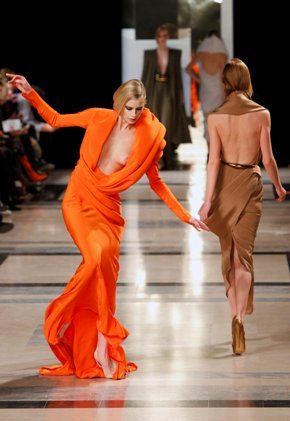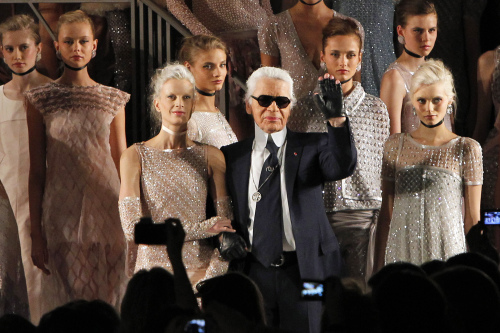PARIS (AP) ― Haute couture got tugged in opposite directions on Tuesday, as Chanel channeled the street ― embracing the mixed-up, casual-chic styles of today’s trendsetting It Girls ― while Givenchy sent out what can only be described as extreme haute couture ― breathtaking, Baroque garments that crossed the divide between clothes and art.
Karl Lagerfeld said he had “Gossip Girl” star and new Chanel spokesmodel Blake Lively in mind when designing the spring-summer 2011 haute couture collection, which layered delicate hand-beaded jackets over skinny jeans and flats.
But at Givenchy, on the other hand, the rarified world of couture got set at even greater remove from reality with a capsule collection of tulle gowns entirely covered in pearls, sequins, beads, chiffon petals and ostrich feathers. More objects to be admired than clothes to be donned, the dresses took up to 4,000 hours of painstaking labor a piece and fetch six-figure prices.
French designer Stephane Rolland, who’s built an enviable client roster since opening his exclusive haute couture label a little over three years ago, continued to show why he’s become a favorite of princesses worldwide. His collection was made for women whose packed social calendars provide them ample opportunities to work dramatic statement gowns.
Lebanon’s Georges Chakra aimed at a similar demographic with his vegetation-inspired collection of cocktail dresses that sprouted tufts of tulle and glinted with swaths of sequins. Oversized ruffles dressed up the beaded bodices, and princess skirts were full and flouncy.
Karl Lagerfeld said he had “Gossip Girl” star and new Chanel spokesmodel Blake Lively in mind when designing the spring-summer 2011 haute couture collection, which layered delicate hand-beaded jackets over skinny jeans and flats.
But at Givenchy, on the other hand, the rarified world of couture got set at even greater remove from reality with a capsule collection of tulle gowns entirely covered in pearls, sequins, beads, chiffon petals and ostrich feathers. More objects to be admired than clothes to be donned, the dresses took up to 4,000 hours of painstaking labor a piece and fetch six-figure prices.
French designer Stephane Rolland, who’s built an enviable client roster since opening his exclusive haute couture label a little over three years ago, continued to show why he’s become a favorite of princesses worldwide. His collection was made for women whose packed social calendars provide them ample opportunities to work dramatic statement gowns.
Lebanon’s Georges Chakra aimed at a similar demographic with his vegetation-inspired collection of cocktail dresses that sprouted tufts of tulle and glinted with swaths of sequins. Oversized ruffles dressed up the beaded bodices, and princess skirts were full and flouncy.

Gustavo Lins was at the opposite end of the spectrum. There was not a sequin in sight among the offerings of the Brazilian-born architect-by-training. His season-less collection was a black, white and charcoal affair, with kimono-cocoon coat hybrids worn over simple sundresses in hand-painted silk or knit wrap dresses. Lins’ was a lovely, if low-key, collection.
Worth ― the resuscitation of a house founded in 1858 by a British dressmaker widely considered the father of haute couture ― served up more of the tutus that have become its hallmark since the long-shuttered label resumed its couture line last year.
Its Italian designer, Giovanni Bedin, said he’d taken his inspiration from the house’s “night and day” costume ― an 1880 ball gown embroidered with the symbols, insects and animals of day and nighttime. Bedin covered his tutus with the same symbols, sticking a lacy bat onto an all-black tutu and dusting another with golden honeybees.

After the end of the day’s shows, the fashion elite descended on a remodeled Gucci boutique in Paris’ swanky 8th district. Amid display cases of pricey handbags and jewelry, celebrities like Diane Kruger and Jessica Alba mingled with the fashion editors, journalists and stylists who lapped up the Champagne and decimated the hors d’oeuvres.
Haute couture displays wrap up on Wednesday with shows by the man who gave the world Madonna’s pointy bra, France’s Jean Paul Gaultier, and Italian luxury label Valentino.
Chanel
Who says couture is for old ladies?
Lagerfeld injected the Chanel collection with a shot of youthfulness, layering hand-embroidered jackets, A-line dresses and miniskirts that glinted with millions of hand-embroidered beads over skinny jeans.
“This is the way the young women of today dress,” Lagerfeld told journalists in a post-show interview as he sipped from an oversized goblet of Diet Coke. “It’s not like the old days anymore, and couture has to be able to change and adapt.”
If there’s one thing Lagerfeld knows how to do, it’s that: The ponytailed designer has spent decades adapting Coco Chanel’s iconic looks to the esprit du temps, with consistently fresh and bankable results.
His casual-chic couture had its finger so firmly on the pulse of hot young things that it was difficult not to imagine It Girls like Lively or her “Gossip Girl” co-star Leighton Meester wearing the jackets in pearly pink tweed with the skinny, stonewashed jeans and pointy flats.
The ravishing collection managed to be fresh and street-oriented without compromising the essence of haute couture ― the rarified and astronomically priced made-to-measure lines that showcase the savoir-faire of the labels’ craftspeople.
Chanel’s embroiderers were in the spotlight on Tuesday, as the show ended with jackets, gowns, pants and ankle-length coats made from nude tulle covered, Lagerfeld said, in more than 10 million glinting beads. Nearly transparent, the looks were so heavily embroidered you could see nearly nothing through the shine of the metallic beads.
Givenchy
Each piece was so loaded with hand-cut, hand-stitched, hand-embroidered, hand-applied elements it was impossible even to know where to look.
At the stork-shaped mosaics made from tiny pieces of silk that embellished the front of a long tulle dress? At the swish of pearls ― each hand-wrapped in mauve organza ― that swirled across the midriff of another gown? At a kimono style jacket made from 64-centimeter wide strips of leather, with sculpted, hot-pink volumes on the back?
The label’s Italian-born designer, Riccardo Tisci, heaped detail onto detail, flourish onto flourish, embellishment onto embellishment to create 10 almost surrealistic Baroque masterpieces.
For the second straight season, Givenchy chose to unveil its couture collection with a two-day-long presentation instead of a runway show. Rumors swirled that the label was in dire financial straits and the presentation was a cost-cutting measure, but staffers insisted the format was aimed at allowing the press and potential clients to fully appreciate the clothes, which would be lost in the blur of a fashion show.
They also insisted the collection was the most expensive the house has ever done ― a credible claim when you consider that a long tulle gown entirely covered in tiny ecru sequins took 4,000 hours to make. Other slightly less elaborate pieces averaged about 3,000 hours, staffers said.
At the presentation journalists leaned in to inspect the clothes and stroked and petted them with the extreme care usually reserved for precious porcelain vases or newborn babies. Models circulated in two of the looks, and some of the fashion people stroked and petted them, too, without ever acknowledging there was a woman inside the garments.
Stephane Rolland
Rolland’s collection was literally architectural, using elements usually more associated with buildings than clothing ― like metal or glass ― to punctuate the fluid silken eveningwear.
Elongated silver tubes clung to the bustier of flowing gowns in liquidy silks, while gleaming gold cables snaked round the cuffs and necklines of stark white column dresses. Teardrop-shaped baubles in blown glass, with flecks of real gold trapped inside, gleamed at the waistline of a single-sleeve number.
The shapes were big and bold, with voluminous draping and long, fluttering skirts that nearly tripped up a couple of the models, all perched on towering heels.
Sun-baked colors, like ochre, burnt sienna and cocoa, gave the collection a more relaxed feeling than the dramatic jewel tones of seasons’ past. But still, the bold metal and glass accents added an edginess that kept the ravishing collection from getting too relaxed.








![[KH Explains] How should Korea adjust its trade defenses against Chinese EVs?](http://res.heraldm.com/phpwas/restmb_idxmake.php?idx=644&simg=/content/image/2024/04/15/20240415050562_0.jpg&u=20240415144419)










![[Today’s K-pop] Stray Kids to return soon: report](http://res.heraldm.com/phpwas/restmb_idxmake.php?idx=642&simg=/content/image/2024/04/16/20240416050713_0.jpg&u=)